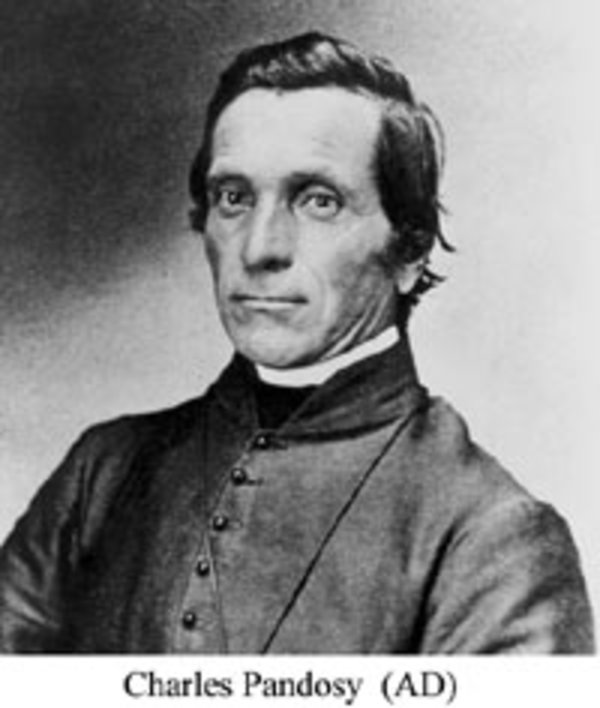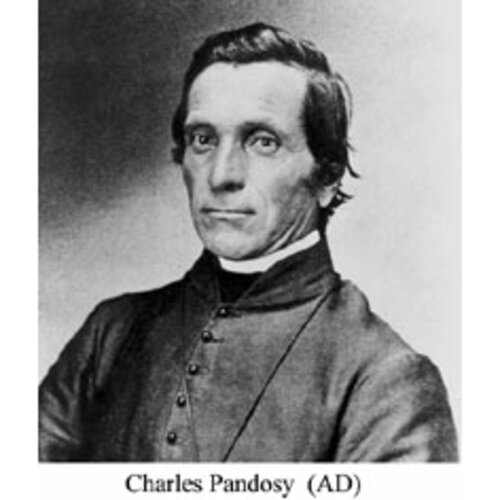
Source: Link
PANDOSY, CHARLES (baptized Jean-Charles-Jean-Baptiste-Félix, also called Charles-John-Adolph-Felix-Marie), Oblate of Mary Immaculate, Roman Catholic missionary, and priest; b. 22 Nov. 1824 in Marseilles, France, son of Esprit-Étienne-Charles-Henri Pandosy, a sea captain, and Marguerite-Josephine-Marie Dallest; d. c. 6 Feb. 1891 in Penticton, B.C.
Charles Pandosy attended the Bourbon college at Arles, France, and then the Oblate juniorate of Notre-Dame de Lumières. He entered the noviciate at Notre-Dame de l’Osier on 14 Aug. 1844 and took his vows on 15 Aug. 1845. Assigned to the missions in the Oregon Territory, the 22-year-old set sail from Le Havre on 4 Feb. 1847 in the company of a small party of Oblates led by the Reverend Pascal Ricard. The group disembarked in New York and travelled overland to Fort Walla Walla (Wash.), arriving on 3 October.
The Oblates established their mission to the Yakima Indians that month with the construction of St Rose mission at the junction of the Yakima and Columbia rivers. The first recorded Indian baptism in the area of present-day Ellensburg was performed by Pandosy on 30 Nov. 1847 (the day after the outbreak of the Cayuse War [see Peter Skene Ogden*]). Following his ordination to the priesthood on 2 Jan. 1848, he resided at St Mary’s, a new mission to the Yakimas, on Mnassatas Creek. In the spring of 1852 he and the Oblate Louis-Joseph d’Herbomez* established St Joseph’s mission on upper Ahtanum Creek. During the next few years he wintered alone at Moxee (Moxee City) and at Aberski. He became fluent in the Yakima language and compiled a dictionary.
Pandosy soon sensed trouble brewing between the Yakima Indians and the settlers. At the request of Governor Isaac Ingalls Stevens, he served as an interpreter at a council held in May 1855 at Walla Walla, where the Yakimas and other Indian bands signed treaties with the American government. Fighting broke out, however, on 6 October when the United States army went to investigate the murder of Indian agent Andrew J. Bolon. On 10 November Major Gabriel James Rains led a thrust into Yakima country near St Joseph’s mission, but the Indians had scattered. Pandosy and his fellow Oblate Paul Durieu had moved to the Jesuit mission near Fort Colvile (near Colville, Wash.). The troops looted and burned St Joseph’s after digging up a keg of gunpowder from the priests’ garden.
Pandosy returned to Yakima territory, but Governor Stevens ordered him to close the mission and leave the area. Although he had been accused in the press of conspiring with Kamiakin, the chief of the Yakimas, he was soon asked to serve as an interpreter and negotiator with the Indians and as chaplain to the American army. He also continued to work with the Jesuits among the Colville and Cœur d’Alêne tribes. Lieutenant Charles William Wilson, re, of the British boundary commission described him as “a very pleasant, well-informed man” who had “a fine voice” and did not “despise the cup that cheers.” He carried “a blanket & a piece of bacon behind his saddle” and was “ready for travel anywhere.” In May 1858 war flared up again between the United States army and the Yakima and Spokan Indians. The Oblates, convinced that “neither prudence nor the good of religion justified the re-establishment of the missions among the Yakimas and the Cayuses,” moved Pandosy to the Oblates’ new headquarters at Esquimalt, Vancouver Island, and assigned him to open a mission in southern British Columbia.
During the summer of 1859 Pandosy travelled with a small group of assistants to the Okanagan valley to establish the first permanent white settlement, the Immaculate Conception mission, with which he has come to be identified. His group built a house and a chapel. During his career he was transferred frequently: to Esquimalt (1861), to Fort Rupert, Vancouver Island (1863), to St Mary’s mission on the lower Fraser (1872), and again to the Okanagan (1874). He travelled to France in 1880 to lay before his superiors the matter of a false claim he and Durieu had made to the United States government regarding losses during the Yakima War. He then served at St Mary’s mission (1880) and was superior at Stuart Lake (1882) before returning finally to the Okanagan, probably in 1887.
During his terms in the Okanagan, Pandosy spent much of his time in Penticton, being responsible for the area south of Immaculate Conception mission. In this period the first fruit-trees in the valley were planted. Pandosy encouraged settlers to pre-empt land in this fertile area and introduced the Indians of the region to agriculture. His popularity with parishioners is attested to in the letters of his colleagues and in surviving stories. Yet his relations with many of his colleagues, especially Pierre Richard, Julien Baudre, and Durieu, were extremely bitter, and their letters abound with mutual denunciations. The issues were numerous: the thoroughness of the conversion of the Indians, the pettiness and rigidity of the administration, accusations by Pandosy of “deception” on the part of his colleagues, and a host of minor personal irritants.
Pandosy died in Penticton in 1891 and was interred at Okanagan mission, but the location of the grave and even of the cemetery was uncertain until 1983, when two students under the direction of James Baker of Okanagan College found a cemetery and excavated several coffins, one of which contained the remains of an Oblate priest. Identification was not conclusive, however.
Since his death, Pandosy has achieved the status of folk hero in the Okanagan. Films and plays have been made based on his life, a street in Kelowna and a winery are named after him, and the site of the old Immaculate Conception mission is commonly referred to as the Father Pandosy mission.
C. [W.] Wilson, Mapping the frontier: Charles Wilson’s diary of the survey of the 49th parallel, 1858–1862, while secretary of the British boundary commission, ed. G. F. G. Stanley (Toronto, 1970). Gaston Carrière, Dictionnaire biographique des oblats de Marie-Immaculée au Canada (3v., Ottawa, 1976–79). Kay Cronin, Cross in the wilderness (Vancouver, 1960). R. A. Fowler, The New Caledonia mission: an historical sketch of the Oblates of Mary Immaculate in north central British Columbia (British Columbia Heritage Trust, New Caledonia heritage research report, Burnaby, 1985). T. W. Paterson, The Okanagan-Similkameen (Langley, B.C., 1983), 156–67. Derek Pethick, Men of British Columbia (Saanichton, B.C., 1975). The Yakima valley Catholic centennial, 1847–1947: a commemoration of the first one hundred years of Catholicity in the Yakima valley ([Moxee City, Wash.?, 1947]).
Cite This Article
Duane Thomson, “PANDOSY, CHARLES (baptized Jean-Charles-Jean-Baptiste-Félix) (Charles-John-Adolph-Felix-Marie),” in Dictionary of Canadian Biography, vol. 12, University of Toronto/Université Laval, 2003–, accessed April 24, 2025, https://www.biographi.ca/en/bio/pandosy_charles_12E.html.
The citation above shows the format for footnotes and endnotes according to the Chicago manual of style (16th edition). Information to be used in other citation formats:
| Permalink: | https://www.biographi.ca/en/bio/pandosy_charles_12E.html |
| Author of Article: | Duane Thomson |
| Title of Article: | PANDOSY, CHARLES (baptized Jean-Charles-Jean-Baptiste-Félix) (Charles-John-Adolph-Felix-Marie) |
| Publication Name: | Dictionary of Canadian Biography, vol. 12 |
| Publisher: | University of Toronto/Université Laval |
| Year of revision: | 1990 |
| Access Date: | April 24, 2025 |



